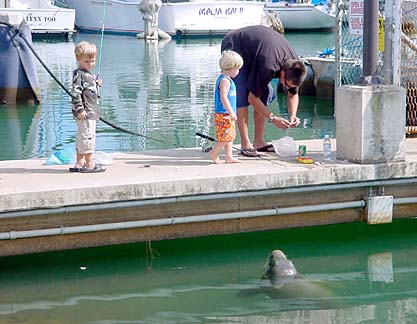
PHOTO COURTESY OF SHAWN FARRY
A male Hawaiian monk seal, dubbed "Lucky" by wildlife officials, has been begging for food at Nawiliwili Harbor over the past week, prompting the state Department of Land and Natural Resources to post a sign warning people not to feed it.
Public warned away
from 2 sealsIncidents of feeding and human
contact prompt the reminders
Wildlife officials are warning people to avoid feeding or touching Hawaiian monk seals, after two of the endangered animals were getting too cozy with humans on Kauai and the Big Island.
People have recently been feeding an adult male known as K07, or "Lucky," in Kauai's Nawiliwili Harbor. The animal swims up to docks and begs for fish, said Shawn Farry, a biologist who has researched monk seals in the Northwestern Hawaiian Islands for the National Oceanic and Atmospheric Administration's Fisheries Service.
"People have a hard time resisting those big brown eyes," Farry said. But they must -- for the good of the seal and the people, too, he said.
The more time a seal spends around people in harbors, the more risk it could be injured by a propeller, tangled in nets or hooked by a fishing line, Farry said.
And people could get bitten if the seal begs for food and does not get any. "He's a 600-pound animal," Farry said. "He may not have the intention to hurt somebody, but may incidentally."
"Potentially, if he keeps it up, he might have to be relocated," Farry said of Lucky, so called because of scars that seem to show the seal survived a shark attack or propeller wound.
Another seal, RM34, born on the Big Island, has recently been relocated twice. Swimmers in Kealakekua Bay said they were "nipped and groped" by the seal Oct. 17, prompting wildlife officials to move it Oct. 20 to South Point, its birth area. By last weekend the seal was back at Kealakekua Bay.
On Tuesday, RM34 was taken by boat to Kahoolawe in hopes that the island's small population of seals and lack of humans might prove a suitable new home, said Jeff Walters, a biologist with the state Division of Aquatic Resources.
Walters said such relocations are rare.
There are an estimated 1,200-1,400 Hawaiian monk seals, most of them in the uninhabited Northwestern Hawaiian Islands.
More than 50 seals have been identified in recent years as living around the main islands, prompting concerns about their health and well-being. The NOAA Fisheries Service is now studying the seals in the main Hawaiian Islands.
"Responsible wildlife viewing includes no approaching, touching, petting or disturbing," said Margaret Akamine, an NOAA Fisheries Protected Resources Division manager. "When curious seals approach people, we recommend that people steer clear -- even if that means getting out of the water until the seal loses interest and swims off."
Seal sightings can be reported to the NOAA Fisheries' toll-free, 24-hour Marine Mammal Hotline at 888-256-9840.
